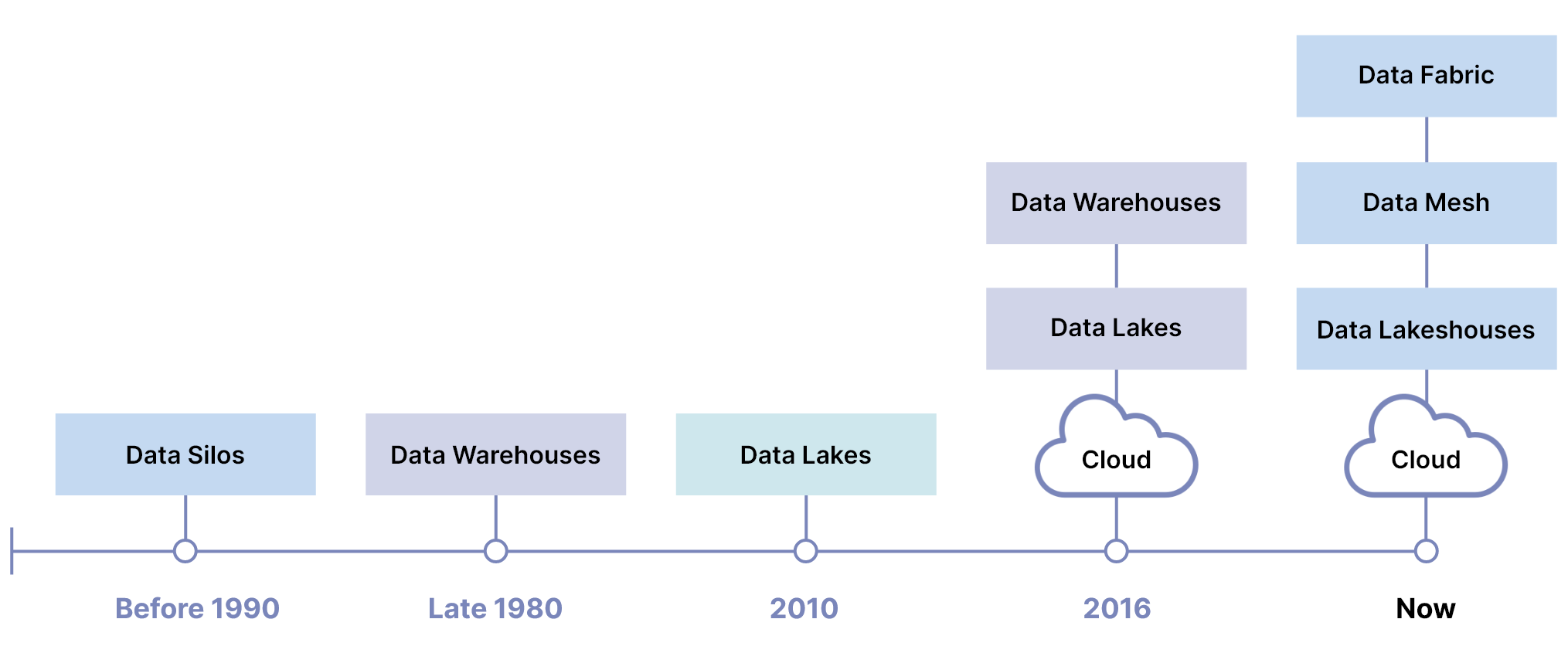Many organizations make inefficient data choices because they are unsure of the purpose and use of popular data architectures such as data warehouses, data lakes, data hubs, lakehouse, data fabric, and data mesh. A comparative view based on technology and business requirements is necessary when selecting a suitable architecture. Selecting the wrong one can result in future complications and uncoordinated not-so-successful investment decisions.
The evolution of data architectures
Data architecture is a big umbrella term that encapsulates everything from data storage to computing resources and everything in between. The architecture includes all the technology that facilitates data collecting, processing, dashboarding, and also operational aspects like usage and compliance. Data architectures evolved from the requirements of consolidating and integrating data from various distinct transactional systems. Modern architectures like Data Mesh and Data Lakehouse help integrate both transactional (data origins) and analytical (convert data to insights) aspects seamlessly across platforms. The evolution of data architecture can be summarised using the below diagram –

Modern data architectures
Let’s go through a few of these architectures, their top benefits, and shortfalls:
- Data Warehouse:Data Warehouse design aims to move data from operational systems to business intelligence systems, which have historically assisted management with operations and planning. A data warehouse is where you store data from multiple data sources to be used for historical and trend analysis reporting. The biggest benefit of a data warehouse is that it provides a consolidated point of access to all data in a single database and data model. One of the limitations of data warehouse is reported mostly when there is a requirement to modify data during ingestion, and this modification causes system instability.
- Data Lake The Data Lake architecture is the extension of the good old warehouse architecture. With the explosion of unstructured and semi-structured data, there was a greater need to extract insights from them to make effective decisions. It is well known to be an inexpensive choice to store unlimited data and allows for faster transformations due to multiple running instances. Limitations include the possibility of multiple data copies in various layers thus increases the cost of ownership and maintenance.
- Data Mesh Data Mesh is distributed architecture paradigm based on domain-oriented ownership, data as a product, self-serve data infrastructures, and federated data governance. Its decentralized data operations and self-serve infrastructure enable teams to be more flexible and independent, improving time-to-market and lowering IT backlog. However, domain-specific LOBs are needed for managing skills to enable the data pipeline. This turns out to be an added responsibility for business stakeholders and not for IT.
There are many other types of data architectures and pros & cons to each one of them with some appealing characteristics which make them unique.
Which modern data architecture model makes the most sense for you?
It is a difficult choice since each framework has its advantages and disadvantages, but you do have to choose if you want to make the most of your data. Defining the correct data architecture model for your needs and a future-proof strategy is extremely necessary in the digital age. It is not practical to continuously redefine architecture from scratch, nor does a quick-fix approach work. We need to be able to fit new concepts and components neatly into existing architecture for adapting to changes without disruption.
Infocepts foundational data platform solution helps assess your current ecosystem, design a target state consistent with your strategy, select the best-fit modern data architecture, and implementation using capacity-based roadmaps. Our approach supported by automation enables the creation of modern data platforms using data architectures as per the business case in weeks, not months.
Check Our Advisory Note to Know More
Our advisory note can be used by data and analytics professionals to understand the foundations of the many modern data architecture patterns, their pros, and cons as well as the recommendations and considerations for choosing the ones that fits them the best.
Grab your copy to know leading practices and tips to select your best-fit data architecture.
Recent Blogs

The Future of Supply Chains Is AI-Driven—Is Your Business Ready to Embrace the Change?
July 2, 2025

What Retail Media Can Learn from Instacart’s AI Strategy
June 24, 2025

Beyond Chatbots: How Agentic AI Is Automating High-Stakes Business Decisions
June 11, 2025

From Batch to Real-Time: The Future of Data Distribution Using Databricks Delta Sharing
June 4, 2025


